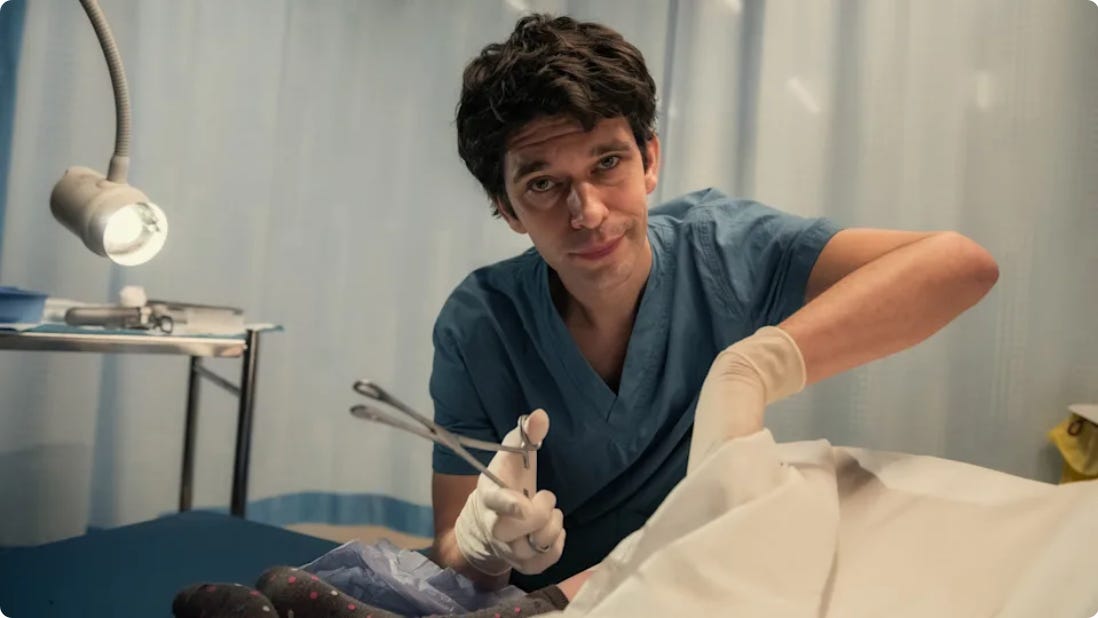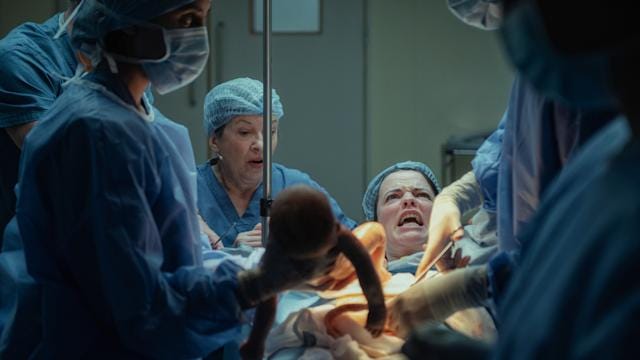The eagerly awaited adaptation of Adam Kay’s best-selling book This Is Going To Hurt hit TVNZ on the weekend. It does exactly as it says on the box - it hurts.
CONTENT WARNING: This review includes detail about birth trauma and the things that can go wrong in birth. It also includes talk about my experience with a chronic pain condition, endometriosis and adenomyosis. It may be distressing to read so please take care.
Here are some websites, organisations and other resources which offer birth trauma support and which may help you on your healing journey. These resources were put together by My Birth Story.
Many people with endometriosis often feel isolated and overwhelmed. Sometimes it’s helpful to talk to someone who ‘gets it’ and who can help you with an evidenced-based plan to address the issues you are facing. Endometriosis NZ offers information, help, support, or advice through their wellbeing service.
I have been rushed by ambulance to hospital with pain so complete I couldn’t see. I have felt as if all of the world had conspired to create in me an agony so all-consuming that I couldn’t breathe. I have been on a morphine drip and I’ve felt as if it was water splashing around an umbrella - my torment barely touched, dry and killing me from the inside.
I’ve given birth to two babies without an epidural - but the worst pain I’ve had wasn’t then. I pushed out one who was so big he took up my entire torso. I went home two hours later, walking out the door holding the hand of my husband. I know pain. I know what I can handle and what I cannot.
It’s something anyone with endometriosis or adenomyosis will understand. That pain, it’s something else. I’ve tried to breathe through the vicious and violent stabbing of it, when I could not feel anything except its totality.
The last time I was in hospital for that pain, the male doctor on the ward looked a little like actor Ben Whishaw as Adam Kay. Though, if I’m honest, years of needing medical attention for endometriosis - the multiple surgeries and multiple hospital stays - means smug male doctors usually just blend into one tired avatar.
I admire doctors. I am in awe of them. I have watched them save my child’s life on more than one occasion. Watched them swoop him out of my hands and run. They are heroes. My husband struggles to speak in front of them - so inspired is he.
They wield great power. The scrubs, the words they use that we can’t understand - that they never repeat. The way they can look at you just so, to make you feel like you’re less than human. A blip on their busy day, one more annoyance before the end of their shift.
I’ve come to know doctors and nurses on the children’s ward who treated us as gently as a broken bird. Others who looked at us like we were less than human. Others were skilled, kind, professional and full of empathy - despite how rushed, exhausted and overworked they were.
I’ve had many internal sonograms, and they’re painful enough without the muscles in your uterus contracting as if you’re in labour. That night, the last time I was in hospital, I had to have one because the doctor ordered it.
And as I drifted in and out of consciousness, in too much pain to cry out, only weeping - I wondered if it was possible to die from the agony.
In the first episode of This Is Going To Hurt we hear that Adam Kay works in Gynecology and Obstetrics, or as he calls it “Twats and brats”. Isn’t that funny?
He sees a woman in labour outside the hospital before his shift starts and he sighs theatrically and looks under her skirt. He sees a baby’s arm. She asks if he’s a real doctor as he isn’t in scrubs. He makes another joke about how she didn’t even ask this before she let him look at her vagina. Isn’t that funny?
She has a cord prolapse. He is wheeled through the hallway with his hand inside her. Another junior doctor, accidentally rams the gurney into a door. We can barely see the labouring woman, the camera centres on Dr Kay. None of the women are anything but places for babies to come out of. They’re as invisible as the midwives. Isn’t that funny?
He makes a joke about how he’s “wearing her like Kermit the Frog”. Do you get it? Because he’s got his hand inside her. The perinatal mortality rate from cord prolapse is estimated to be about 91 per 1,000.
He takes a phone call while an ill-equipped junior doctor who has never used forceps before is ignored to deliver a baby to a woman of colour. Jokes are made throughout about vaginas as this new mother’s vagina tears. Black women are more than three times more likely to die in pregnancy and postpartum than white women.
Another pregnant patient is very stupid. When Dr Kay asks her how far along she is, she thinks he’s talking about her age. Her apparent stupidity is her main characteristic. Every woman on the show is a parody - the stupid, young mother. The rich, workaholic mother. The hypochondriac. The woman who wants to eat her placenta. The immigrant with the husband who can’t speak English. Isn’t that funny?
The Idiot Mother asks him to look at her tongue and he diagnoses her with “taste buds”. Isn’t that funny? She later returns to hospital for an emergency cesarean and has her baby delivered too early, at 25 weeks. It’s all a lesson for Dr Kay, but also she’s stupid so what did she expect?
I might sound like I have no sense of humour. That I just don’t get what a black comedy is. But, I guess the jokes just aren’t funny when you know all of the nameless women in the first episode of this show.
They are the women who talk about their birth trauma in whispers, tears falling so hard and fast that they drip all the way down to their leaking breasts. They are the women who were told ‘all that matters is you got a healthy baby’ as they nurse violent perineal lacerations and tears, trying to inhabit a body that will never, ever be the same again.
I know the women who lie vomiting on the floor of the bathroom rather than call an ambulance because they have faced too many male doctors who don’t believe their pain. Who think they’re hypocondriacs. Stupid.
I know the women who have been the butt of jokes as they care for new babies, as they try to emerge from one of the worst experiences of their lives fully formed as mothers. Those who as a result of their births are now incontinent. Those who have pelvic organ prolapse, who are constantly in pain.
And I know what it’s like to have my body violated on a gurney so that a doctor can tick off a box on a list before sending me home with Panadol.
It is a fact that women in both acute pain and chronic pain are underdiagnosed and undertreated — and it's even worse for women of colour and indigenous women.
In the emergency room we see the gender pain gap. Men wait an average of 49 minutes before being given pain meds in instances of acute abdominal pain while women wait an average of 65 minutes. After coronary bypass surgery, women are even half as likely as men to receive painkillers.
Two studies last year identified a bias towards underestimation of pain in female patients, which they found was related to gender stereotypes.
Not only do they tend to underestimate women’s pain but, on the basis of their underestimate, they often under-treat pain. A 2016 study found women are often recommended psychological rather than analgesic treatment to handle pain.
Devastatingly, this view that women do not feel pain at the same severity as men, can be seen even in children. The study Gender Biases in Adult Ratings of Pediatric Pain found observers who watched a video of a child having blood drawn believed the child described as “Samuel” had higher pain than the same child who was described as “Samantha”.
This Is Going To Hurt is an important insight into how overworked doctors are in the NHS. In New Zealand doctors seem to love it - describing it as realistic. In later episodes, it deals with depression and burnout.
It is important to recognise the way doctors have put their lives on the line during the pandemic - emotionally and physically. It is important that we acknowledge what they’ve had to go through and what that does to a person. But you can’t humanise burnt out doctors by dehumanising women and mothers.
We can and should honour doctors and health professionals and we should seek insight into what it’s like to work in under-funded and overwhelmed public health systems. But we can do that without making women the butt of every single joke. We can do that and acknowledge the way some male doctors view women, unconciously or consciously. We can do that and highlight the ways that women are the ones left with the worst scars of resource-stretched hospitals.
I think people will say this show is just not for us - but we can, and should, ask for more from media that shapes the way we view the world.
Much is said about how birthing people should just avoid This Is Going To Hurt. I know that. I think we all know: It’s not for us. But if all the first episode does is cement stereotypes about women and pain, in particular woman in birth, then I wonder who it’s for…
For many of us, we’ve seen enough of that hurt, and yes - it really does hurt.
And it’s just not funny.






I thought I’d share this I was sent anonymously from a doctor because I think she makes a really good point about the time period of the piece - “This is a great take. I’m a GP, and I loved the book, but I am hurt by the treatment of women played for laughs and the dehumanised nature of the patients in general. Thanks for writing. It is important to consider that it is a period piece - I hadn’t finished highschool when it is set, and I’ve been a doctor for 9 years now. Things are improving, more women are doctors, and people are better supported generally.”
Emily you’ve described this all so well. That’s exactly how I felt after watching the first episode. Thank you for articulating this.
The thing I found a bit weird is that I read his book, and have read other ones by him, and really enjoyed them, felt that Kay is a heartfelt person. I don’t know if something was lost in translation when making the tv show, or I somehow missed any dehumanisation in the first place.
One sensation I had after watching the first episode (I couldn’t face watching any more) was a familiar sense of being a killjoy and a nag, because the show got so many glowing reviews and I couldn’t understand it. I wanted to express my confusion and hurt but also felt I shouldn’t, because I must have it wrong; my reaction must be wrong. It makes me realise how much these ‘killjoy’ and ‘nag’ stereotypes must have their origin in women being supremely unheard, unseen and disregarded.